2018 MERCEDES-BENZ SLC warning light
[x] Cancel search: warning lightPage 56 of 298

G WARNING
If you leave children unsupervised in the vehi-
cle, they coul ds et it in motion by, for example:R
release the parking brake. R
shift the automatic transmission out of the
parking position P .R
start the engine.
In addition, they may operate vehicl ee quip-
ment and become trapped. There is ar isk of
an accident and injury.
When leaving the vehicle, alway st ake the
SmartKey with you and lock the vehicle. Never
leave children unsupervised in the vehicle.
G WARNING
If persons, particularl yc hildren are subjected
to prolonged exposure to extreme hea to r
cold, there is ar isk of injury ,p ossibly even
fatal .N ever leave children unattended in the
vehicle.
G WARNING
If the child restraint system is subjected to
direct sunlight, parts may get very hot. Chil-
dren may burn themselves on these parts,
particularl yont he metal parts of the child
restraint system. There is ar isk of injury.
If you leave the vehicle, taking the child with
you ,a lway se nsure that the child restraint
system is not expose dtod irect sunlight. Pro-
tect it with ab lanket, for example. If the child
restraint system has been expose dtod irect
sunlight, let it cool dow nb efore securing the
child in it. Never leave children unattended in
the vehicle.
Always ensure that all vehicl eo ccupants have
their seat belts fastened correctly and are sitting
properly .P articular attention must be pai dt o
children.
Observe the safety notes on the seat belt
( Y
pag e4 0) and the notes on correct use of seat
belts ( Y
pag e4 1).
Ab ooster seat may be necessary to achieve
prope rs eat bel tp ositioning for children over
40 lbs (18 kg )u ntil they reach ah eight where a three-point seat bel tc an be properly fastened
without ab ooster seat.
Special seatbelt retractor
G WARNING
If the seat bel tisr eleased while driving, the
child restraint system wil lnol onger be
secure dp roperly .T he special seat bel tr etrac-
tor is disable da nd the inertia real draw sina
portion of the seat belt. The seat bel tc annot
be immediatel yr efastened. There is an
increased risk of injury ,p ossibly even fatal.
Stop the vehicl ei mmediately, paying atten-
tion to road and traffic conditions. Reactivate
the special seat bel tr etractor and secure the
child restraint system properly.
The seat bel tont he front-passenger's side is
equipped with as pecial seat bel tr etractor.
When activated, the special seat bel tr etractor
ensure st hat the seat bel tc annot slacken once
the child seat is secured.
Installing ac hild restraint system: X
Make sure you observe the child restraint
system manufacturer's installation instruc-
tions. X
Pul lt he seat bel ts moothly out of the belt
loop. X
Engage seat bel tt ongue in bel tb uckle.
Activating the special seat bel tr etractor:X
Pul lt he seat bel to ut full ya nd let the inertia
reel retract it again.
Whil et he seat bel tisr etracting, you should
hear ar atcheting sound .T he special seat belt
retractor is enabled. X
Push the child restraint system dow nsot hat
the seat bel tist ight and does not loosen.
Removing the child restraint system and deac-
tivating the special seat bel tr etractor:X
Make sure you observe the child restraint
system manufacturer's installation instruc-
tions. X
Press the release button of the seat belt
buckle ,h old the bel tt ongue and guide it back
toward st he bel tl oop.
The special seat bel tr etractor is deactivated.54
Children in the vehicle
Safety
Page 59 of 298
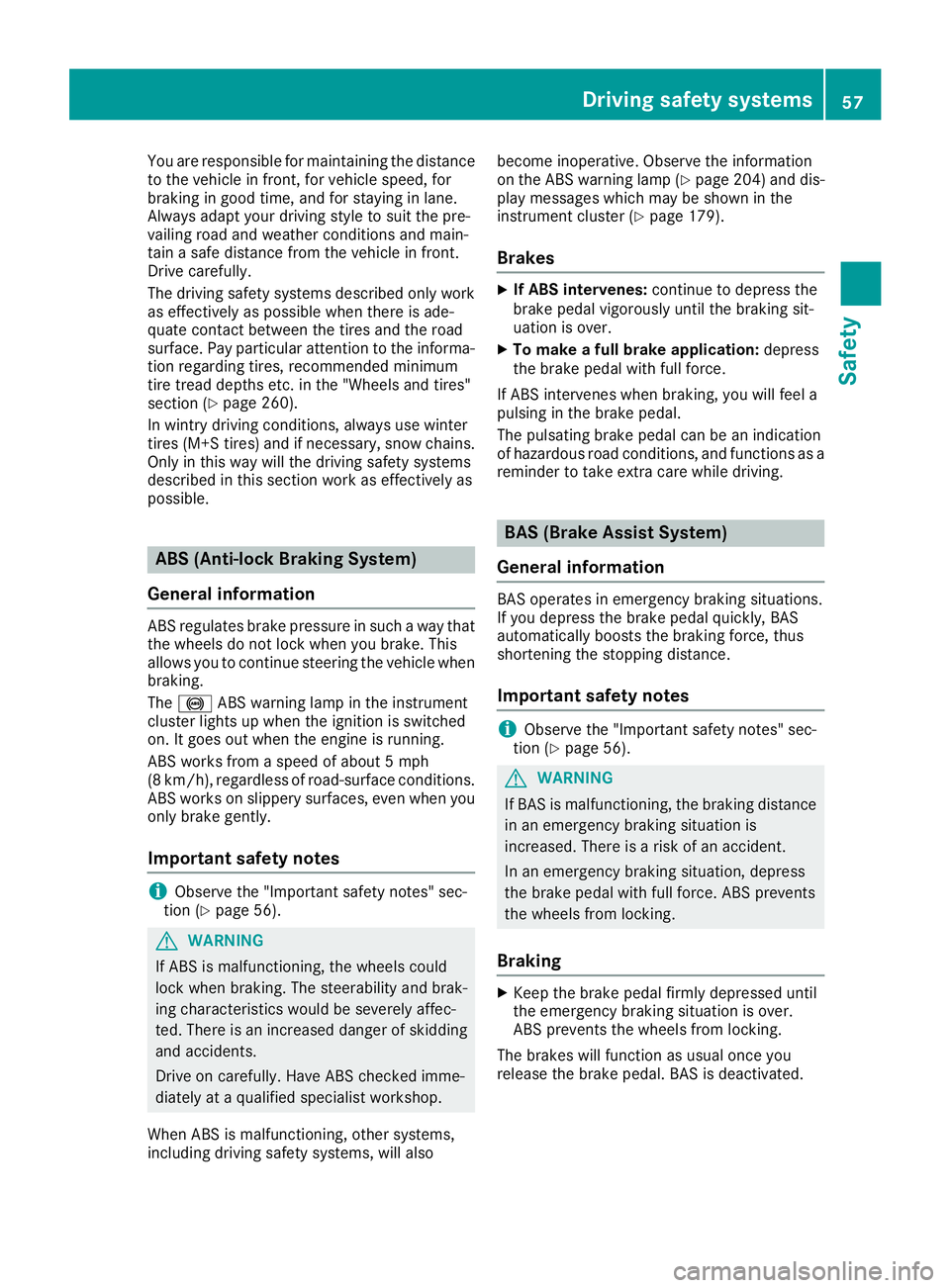
You are responsible for maintainin gt he distance
to the vehicle in front, for vehicle speed, for
braking in good time, and for stayin ginl ane.
Always adapt your drivin gs tyle to suit the pre-
vailing road and weather condition sa nd main-
tain as afe distance from the vehicle in front.
Drive carefully.
The drivin gs afet ys ystems described only work
as effectively as possible when there is ade-
quate contac tb etwee nt he tires and the road
surface. Pay particular attention to the informa-
tion regarding tires, recommended minimum
tir et re ad depth se tc .int he "Wheels and tires"
section ( Y
page 260).
In wintry drivin gc onditions, always use winter
tires (M+S tires) and if necessary, sno wc hains.
Only in this way will the drivin gs afet ys ystems
described in this section work as effectively as
possible.
ABS (Anti-lock Braking System)
Genera li nformationAB Sr egulates brak ep ressure in such aw ay that
the wheels do not lock when you brake. This
allows you to continue steerin gt he vehicle when
braking.
The �% AB Sw arnin gl amp in the instrument
cluster light supw hen the ignition is switched
on. It goes out when the engin eisr unning.
AB Sw ork sf rom as peed of about 5m ph
(8 km/h), regardless of road-surfac ec onditions.
AB Sw ork sons lippery surfaces, even when you
only brak eg ently.
Important safet yn otes
i Observe the "Importan ts afet yn otes" sec-
tion ( Y
page 56).
G WARNING
If AB Sism alfunctioning, the wheels could
lock when braking. The steerabilit ya nd brak-
ing characteristics would be severely affec-
ted. There is an increased danger of skidding
and accidents.
Drive on carefully. Have AB Sc hecked imme-
diately at aq ualified specialis tw orkshop.
When AB Sism alfunctioning, other systems,
including drivin gs afet ys ystems, will also becom ei noperative .O bserve the information
on the AB Sw arnin gl amp ( Y
page 204) and dis-
play messages which may be shown in the
instrumen tc luster ( Y
page 179).
Brakes X
If ABS intervenes: continue to depres st he
brak ep edal vigorously until the braking sit-
uation is over. X
To make af ull brake application: depress
the brak ep edal with full force.
If AB Si ntervenes when braking, you will feel a
pulsing in the brak ep edal.
The pulsatin gb rak ep edal can be an indication
of hazardous road conditions, and function sasa
reminder to tak ee xtra care while driving.
BAS (Brake Assist System)
Genera li nformationBA So perates in emergenc yb raking situations.
If you depres st he brak ep edal quickly, BAS
automatically boost st he braking force, thus
shortening the stopping distance.
Important safet yn otes
i Observe the "Importan ts afet yn otes" sec-
tion ( Y
page 56).
G WARNING
If BA Sism alfunctioning, the braking distance
in an emergenc yb raking situation is
increased. There is ar isk of an accident.
In an emergenc yb raking situation, depress
the brak ep edal with full force. AB Sp revents
the wheels from locking.
Braking X
Keep the brak ep edal firmly depressed until
the emergenc yb raking situation is over.
AB Sp revent st he wheels from locking.
The brakes will function as usual onc ey ou
release the brak ep edal. BA Sisd eactivated.Driving safet ys ystems 57
Safety Z
Page 62 of 298
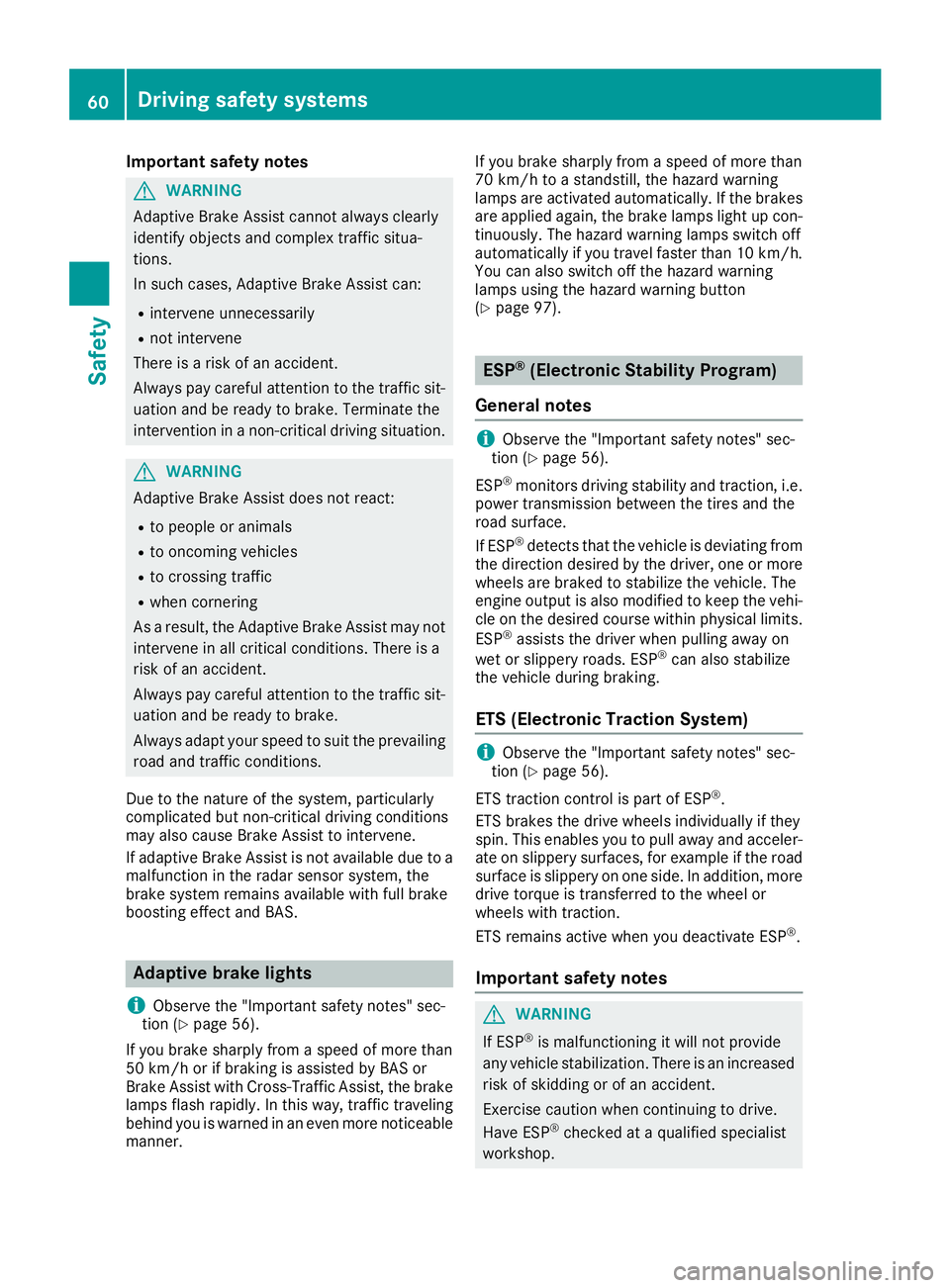
Important safety notes
G WAR NING
Adaptive Brake Assist canno ta lways clearly
iden tif yo bj ect sa nd co mple xt ra ff ic situa-
tions.
In suc hc ases, Adaptive Brake Assist can:R
interven eu nnecessar ilyR
no ti ntervene
Ther eisar is kofana cc iden t.
Always pay careful attentio ntot he traff ic sit-
uation and be read yt ob rake. Terminate the
interventio ninan on-cri tical driv ing situation.
G WAR NING
Adaptive Brake Assist does no tr eact:R
to peop le or animalsR
to oncomin gv eh icle sR
to crossing traff icR
when cornering
As ar esult, th eA da pt ive Brake Assist may not
interven eina ll critical conditions. Ther eisa
ris kofana cc iden t.
Always pay careful attentio ntot he traff ic sit-
uation and be read yt ob rake.
Always adapt your spee dtos uit th ep re vailin g
road and traff ic conditions.
Due to th en ature of th es ystem, particularly
co mpli cated but non-critical driv ing conditions
may also caus eB ra ke Assist to intervene.
If adaptive Brake Assist is no ta vailab le due to a
malfunctio nint he radar sensor system, the
brak es ystem remains availab le wit hf ull brake
boostin ge ffect and BA S.
Adaptive brak el ights
i Observ et he "Im portan ts afety notes" sec-
tio n( Y
page 56).
If you brak es harply from as pee dofm or et ha n
50 km /h or if braking is assiste dbyB AS or
Brake Assist wit hC ross-Traffic Assist ,t he brake
lamps flas hr apid ly. In th is way, traff ic traveling
behin dy ou is warned in an eve nm or en ot ic eable
manner. If you brak es harply from as pee dofm or et ha n
70 km /h to as ta ndstill, th eh azard warning
lamps are activated automatically. If th eb rakes
are applie da gain ,t he brak el amps light up con-
tinuously. The hazard warning lamps switch off
automatical ly if you travel faster than 10 km/h.
You can also switch off th eh azard warning
lamps usin gt he hazard warning button
( Y
page 97).
ESP ®
(Electronic Stability Program)
General notes
i Observ et he "Importan ts afety notes" sec-
tio n( Y
page 56).
ESP ®
monitors driving stabilit ya nd traction ,i .e .
power transmission between th et ires and the
road surface.
If ESP ®
detect st ha tt he vehicle is deviating from
th ed irection desired by th ed river, on eorm ore
wheel sa re braked to stabiliz et he vehicle .T he
engin eo utput is also modifie dtok ee pt he vehi-
cle on th ed esired course wit hin physical limits.
ESP ®
assists th ed river when pullin ga way on
wet or slippery roads. ESP ®
can also stabilize
th ev ehicle durin gb raking.
ETS (Electronic Traction System)
i Observ et he "Importan ts afety notes" sec-
tio n( Y
page 56).
ET St ra ction control is part of ESP ®
.
ET Sb rakes th ed riv ew heel si nd ivid ually if they
spin .T his enables you to pull away and acceler-
ate on slippery surfaces, for example if th er oad
surface is slippery on on es ide .Ina ddit ion ,m ore
driv et or que is transferred to th ew heel or
wheel sw it ht ra ction.
ET Sr emains active when you deactivate ESP ®
.
Important safety notes
G WARNING
If ESP ®
is malfunctionin gitw ill no tp rovide
any vehicle stabilization .T her eisani ncreased
ris kofs ki ddin gorofana ccident.
Exercise caution when continuing to drive.
Hav eE SP ®
checked at aq ualified specialist
worksho p.60
Driving safety systems
Safety
Page 72 of 298
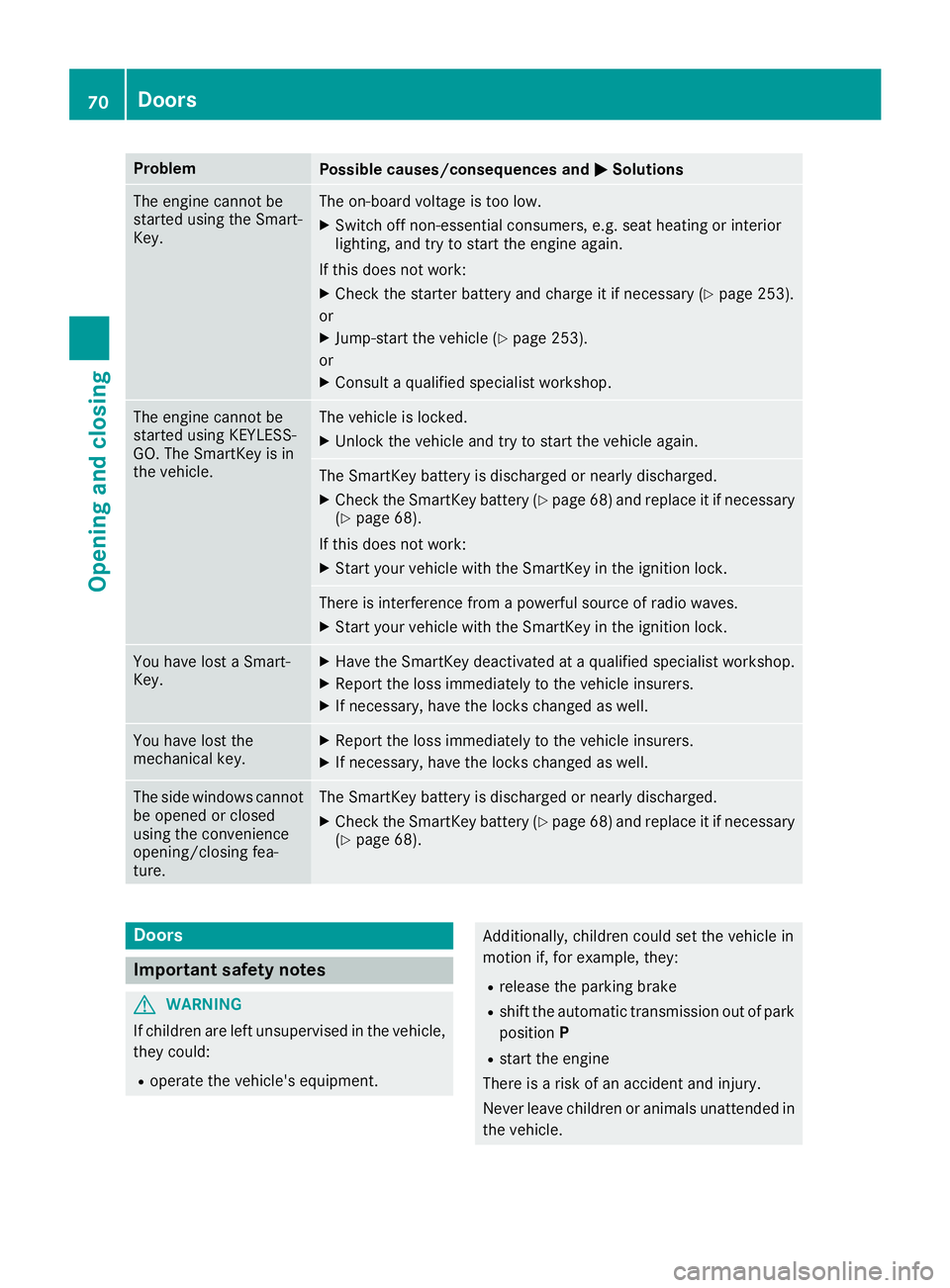
Problem
Possible causes/consequences and �P Solutions
The engine cannot be
started using the Smart-
Key. The on-board voltage is too low. X
Switch off non-essential consumers, e.g. seat heating or interior
lighting, and try to start the engine again.
If this does not work: X
Check the starter battery and charge it if necessary ( Y
page 253).
or X
Jump-start the vehicle ( Y
page 253).
or X
Consult aq ualified specialist workshop.
The engine cannot be
started using KEYLESS-
GO. The SmartKey is in
the vehicle. The vehicle is locked. X
Unlock the vehicle and try to start the vehicle again.
The SmartKey battery is discharged or nearly discharged. X
Check the SmartKey battery ( Y
page 68) and replace it if necessary
( Y
page 68).
If this does not work: X
Start your vehicle with the SmartKey in the ignition lock.
There is interference from ap owerful source of radio waves.X
Start your vehicle with the SmartKey in the ignition lock.
You have lost aS mart-
Key. X
Have the SmartKey deactivated at aq ualified specialist workshop.X
Report the loss immediately to the vehicle insurers. X
If necessary, have the locks changed as well.
You have lost the
mechanical key. X
Report the loss immediately to the vehicle insurers. X
If necessary, have the locks changed as well.
The side windows cannot
be opened or closed
using the convenience
opening/closing fea-
ture. The SmartKey battery is discharged or nearly discharged. X
Check the SmartKey battery ( Y
page 68) and replace it if necessary
( Y
page 68).
Doors
Important safety notes
G WARNING
If children are left unsupervised in the vehicle,
they could: R
operate the vehicle's equipment. Additionally, children could set the vehicle in
motion if, for example, they: R
release the parking brake R
shift the automatic transmission out of park
position P R
start the engine
There is ar isk of an accident and injury.
Never leave children or animals unattended in
the vehicle.70
Doors
Opening and closing
Page 74 of 298

X
To deactivate: press and hol db ut ton �C for
abou tf iv es econds unti lat one sounds.X
To activate: press and hol db ut ton �D for
abou tf iv es econds unti lat one sounds.
If yo up ress one of the two buttons and do not
hea rat one, the relevant setting ha sa lr eady
been selected.
The vehicl eisl oc ked automaticall yw he nt he
ignition is switched on and the wheels are turn-
ing.
Yo uc ould therefore lock yoursel fo ut if:R
the vehicl eisb ei ng pushed.R
the vehicl eisb ei ng towed.R
the vehicl eisonar olle rd yn amometer.
Yo uc an also switch the automatic locking func-
tio nona nd off using the on-board computer
( Y
page 173).
Unlocking/lockin gt he driver's door
using the mechanical key
i If yo uw an ttoc entrall yl oc kt he vehicl eu si ng
the mechanical key ,b egin by pressing the
locking button for the interio rl oc king mech-
anism whil et he driver's door is open. Then
lock the driver's door using the mechanical
key.
X
To unlock: turn the mechanical key counter-
clockwise as far as it will go to position �G .X
To lock: turn the mechanical key clockwise as
far as it will go to position �G .
If yo uu se the mechanical key to unlock and
open the driver's door, the anti-thef ta la rm sys-
tem will be triggered .S witch off the alarm
( Y
page 64). Trunk
Important safety notes
G WARNING
If objects, luggage or load sa re not secured or
not secured sufficiently ,t hey could slip ,t ip
ove rorbef lung around and thereb yh it vehicle
occupants. There is ar is kofi njury ,p ar ticu-
larly in the event of sudden braking or as ud -
de nc hange in direction.
Alway ss tor eo bj ects so tha tt hey canno tb e
flung around .S ecure objects, luggage or
load sa gain st slipping or tipping before the
journey.
! The trunk li ds wi ng su pwar ds when opened.
Therefore, make sure tha tt her eiss uf ficient
clearance above the trunk lid.
! Onl yc lose the trunk once the roo fisl owere d
completely. Otherwise, yo uc ould damag et he
roof.
If yo uc lose the trunk li db ef ore the roo fi s
lowered completely, the loading ai ds wi tch
lights up and aw ar ning tone sounds.
The opening dimensions of the trunk li dc an be
found in the "Vehicle data" section
( Y
page 295).
Do not leave the SmartKey in the trunk. You
could otherwise lock yoursel fo ut .
The trunk li dc an be: R
opened/close df rom outside R
opene da ut omaticall yf rom outsideR
locked separately R
opene dw it ht he emergency release button R
unlocke dw it ht he mechanical key
Yo us houl dp referabl yp la ce luggage or load si n
the trunk.72
Trunk
Opening and closing
Page 76 of 298
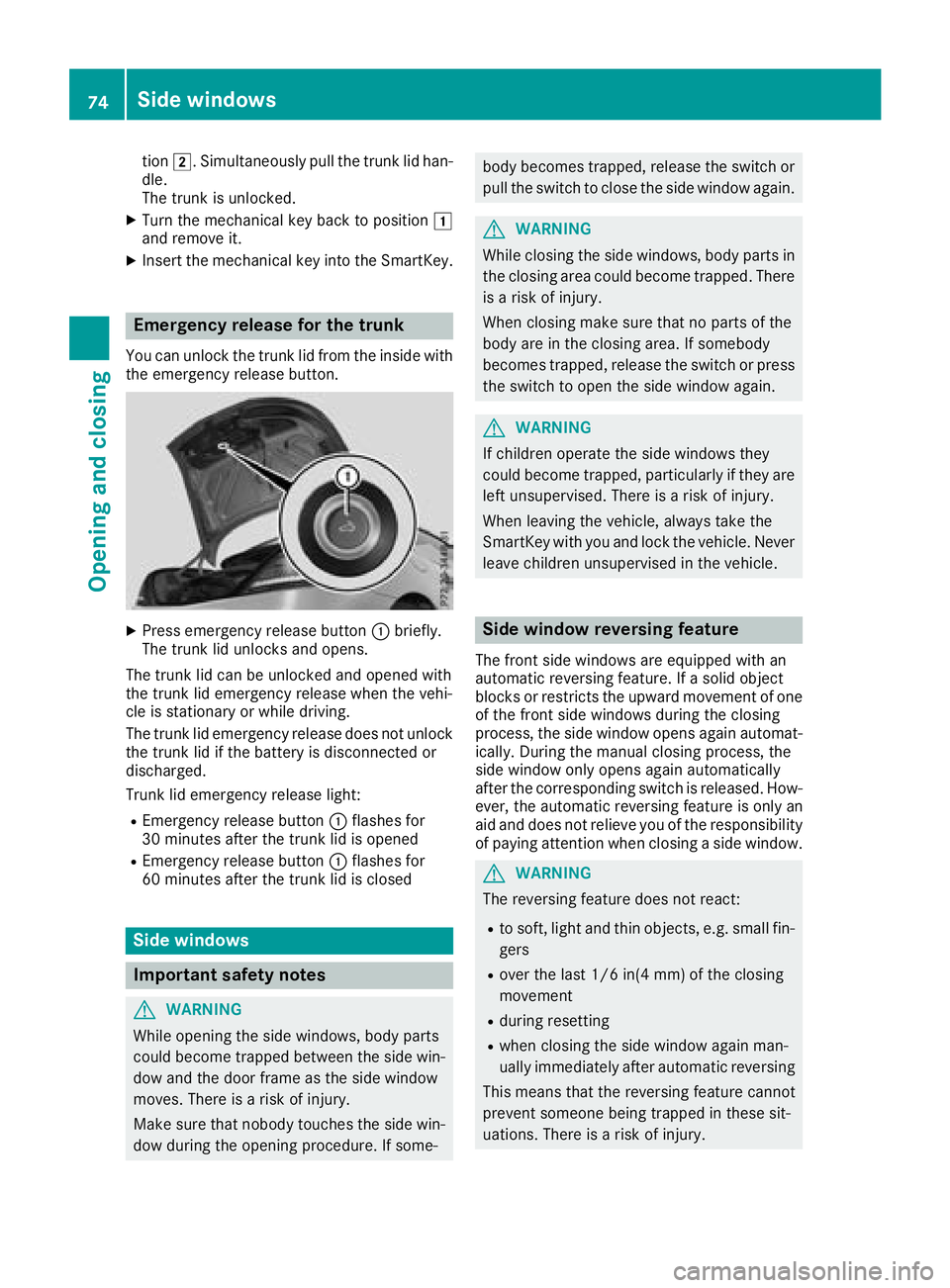
tion �H .S imultaneousl yp ul lt he trunk li dh an -
dle.
The trunk is unlocked. X
Turn the mechanica lk ey back to position �G
and remove it. X
Insert the mechanica lk ey into the SmartKey.
Emergenc yr elease fo rt he trunkYo uc an unlock the trunk li df ro mt he insid ew it h
the emergency release button.
X
Press emergency release button �C briefly.
The trunk li du nlocks and opens.
The trunk li dc an be unlocke da nd opene dw it h
the trunk li de mergency release when the vehi-
cle is stationar yorw hile driving.
The trunk li de mergency release does not unlock
the trunk li dift he battery is disconnecte do r
discharged.
Trunk li de mergency release light:R
Emergency release button �C flashe sf or
30 minute sa ft er the trunk li diso pe nedR
Emergency release button �C flashe sf or
60 minute sa fter the trunk li disc losed
Side windows
Important safety notes
G WARNING
Whil eo pe ning the side windows ,b od yp ar ts
could become trapped between the side win-
do wa nd the door frame as the side window
moves .T here is ar is kofi njury.
Make sure tha tn obod yt ouche st he side win-
do wd ur in gt he opening procedure. If some- body become st rapped ,r elease the switch or
pull the switch to close the side windo wa gain .
G WARNING
Whil ec losing the side windows ,b od yp ar ts in
the closing area could become trapped .T here
is ar is kofi njury.
When closing make sure tha tnop ar ts of the
body ar eint he closing area .Ifs omebody
become st rapped ,r elease the switch or press
the switch to open the side windo wa gain .
G WARNING
If children operate the side windows they
could become trapped ,p ar ticularly if the ya re
left unsupervised .T here is ar is kofi njury.
When leaving the vehicle, always take the
SmartKe yw it hy ou and lock the vehicle. Never
leav ec hildren unsupervised in the vehicle.
Side windo wr eversin gf ea tureThe front side windows ar ee quippe dw it ha n
automatic reversing feature. If as olid object
blocks or restricts the upward movement of one
of the front side windows durin gt he closing
process, the side windo wo pe ns agai na ut omat-
ically. During the manua lc losing process, the
side windo wo nl yo pe ns agai na ut omatically
after the corresponding switch is released. How-
ever, the automatic reversing featur eiso nl ya n
ai da nd does not relieve yo uoft he responsibility
of paying attentio nw he nc losing as id ew in dow.
G WARNING
The reversing featur ed oe sn ot react:R
to soft, light and thi no bj ects ,e .g .s mall fin-
gers R
ove rt he last 1/6 in(4 mm) of the closing
movement R
durin gr esetting R
when closing the side windo wa gain man-
uall yi mm ediatel ya ft er automatic reversing
Thi sm eans tha tt he reversing featur ec annot
prevent someone being trapped in these sit-
uations. There is ar is kofi njury.74
Side windows
Openin ga nd closing
Page 78 of 298
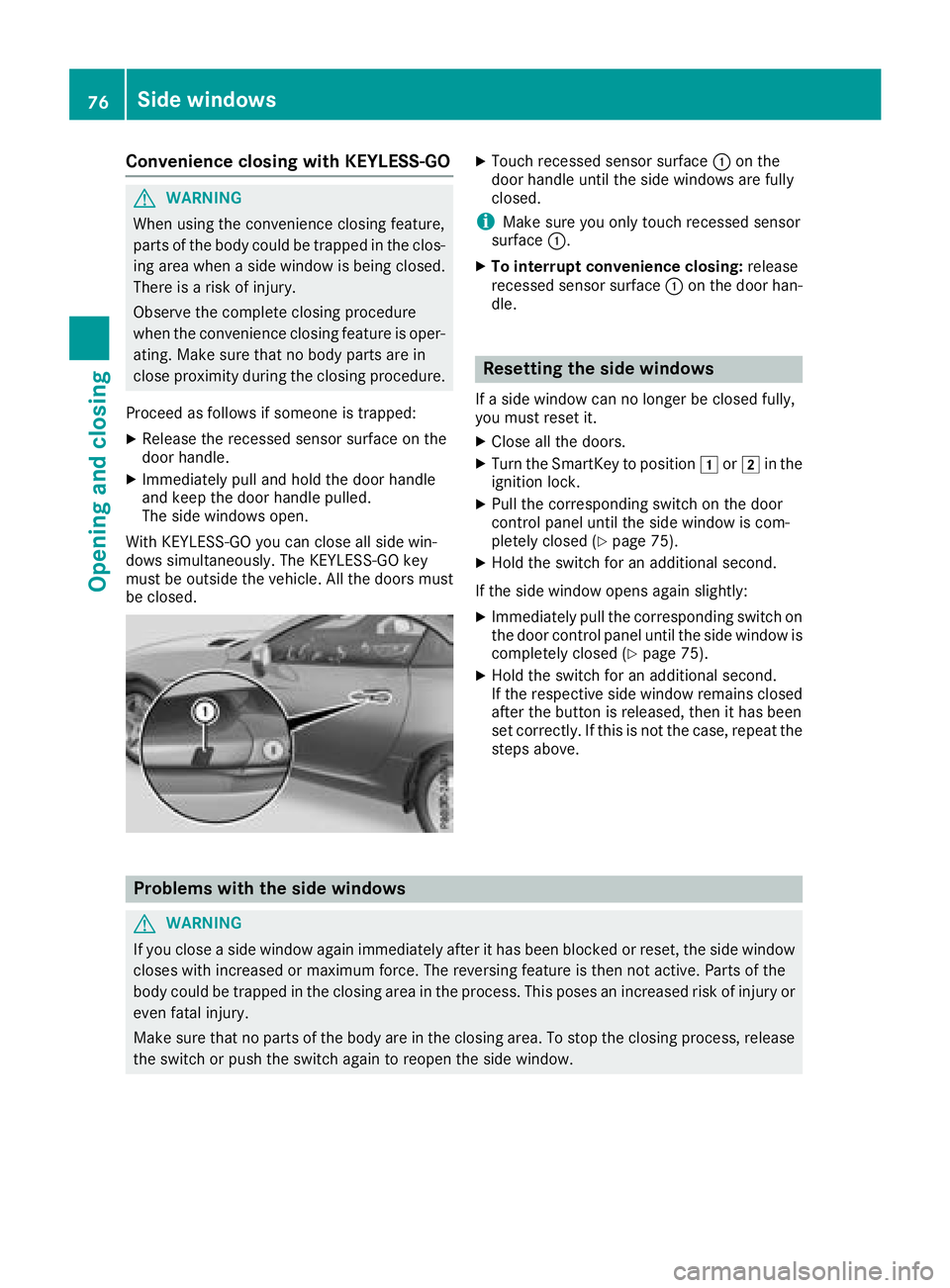
Convenience closing with KEYLESS-GO
G WARNING
When usin gt he convenience closin gf eature,
part soft he body coul dbet ra pped in th ec los-
ing area when as ide window is bein gc losed.
Ther eisar is kofi njury.
Observ et he complet ec losin gp rocedure
when th ec onvenience closin gf eature is oper-
ating. Mak es ure that no body part sa re in
close proximity durin gt he closin gp rocedure.
Procee dasf ollows if someon eist ra pped:X
Release th er ecessed sensor surface on the
door handle. X
Immediately pull and hold th ed oor handle
and keep th ed oor handle pulled.
The side windows open.
Wit hK EY LESS-GO you can close all side win-
dows simultaneously. The KEYLESS-GO key
must be outside th ev ehicle .A ll th ed oor sm ust
be closed. X
Touc hr ecessed sensor surface �C on the
door handle until th es ide windows are fully
closed.
i Mak es ure you only touch recessed sensor
surface �C . X
To interrup tc onvenience closing: release
recessed sensor surface �C on th ed oor han-
dle.
Resetting th es id ew indowsIf as ide window can no longer be closed fully,
you must reset it. X
Close all th ed oors. X
Turn th eS ma rtKey to position �G or �H in the
ignition lock. X
Pull th ec orrespondin gs witch on th ed oor
control panel until th es ide window is com-
pletely closed ( Y
page 75).X
Hol dt he switch for an additional second.
If th es ide window open sa gain slightly:X
Immediately pull th ec orrespondin gs witch on
th ed oor control panel until th es ide window is
completely closed ( Y
page 75).X
Hol dt he switch for an additional second.
If th er espectiv es ide window remains closed
after th eb utto nisr eleased, then it has been
set correctly. If this is no tt he case, repeat the
steps above.
Problem sw ith th es id ew indows
G WARNING
If you close as ide window again immediately after it has been blocke dorr eset ,t he side window
closes wit hi ncreased or maximum force. The reversing feature is then no ta ctive. Part soft he
body coul dbet ra pped in th ec losin ga rea in th ep rocess. This pose sani ncreased ris kofi njury or
eve nf atal injury.
Mak es ure that no part soft he body are in th ec losin ga rea. To stop th ec losin gp rocess, release
th es witch or push th es witch again to reopen th es ide window.76
Sid ew indows
Opening and closing
Page 79 of 298

Problem
Possible causes/consequences and �P Solutions
As ide window cannot be
closed because it is
blocked by objects, e.g.
leaves in the window
guide. X
Remove the objects. X
Close the side window.
As ide window cannot be
closed and you cannot
see the cause. If as ide window is obstructed during closing and reopens again
slightly: X
Immediately after the window blocks, pull the correspondin gs witch
again until the side window has closed.
The side window is closed with increased force.
If as ide window is obstructed again during closing and reopens again
slightly: X
Immediately after the window blocks, pull the correspondin gs witch
again until the side window has closed.
The side window is closed without the automatic reversing feature.
The side windows cannot
be opened or closed
using the convenience
opening/closing fea-
ture. The SmartKey battery is discharged or nearly discharged. X
Check the SmartKey battery ( Y
page 68) and replace it if necessary
( Y
page 68).
Roof
Important safety notes
G WARNING
If you do not fully open/close the soft top, the
soft-top hydraulics depressurize after as hort
time. This causes the soft top to lower unex-
pectedly and may cause you or others to be
trapped. There is ar isk of injury.
Always open or close the soft top completely.
G WARNING
Closing the roof manually is ac omplicated
and technically demanding procedure, which
requires al ot of strength. You or others can
become trapped. There is ar isk of injury.
Only have the soft top closed manually at a
qualified specialist workshop.
! Never sit on the rear shelf or store heavy
object st here. You will otherwise damage the
roof and the rear shelf of your vehicle. ! Do not forget that the weather can change
abruptly. Make certain that the roof is closed
when you leave the vehicle. The vehicle elec-
tronics can be damaged if water enters the
vehicle interior.
! When opening and closing the roof, make
sure that: R
there is sufficient clearance, as the roof
swings upwards. R
there is sufficient clearance behind the
vehicle, as the trunk lid swings backwards
beyond the bumper. R
the trunk is only loaded to below the trunk
partition. R
the trunk partition is not pushed up by the
load. R
the trunk partition is closed. R
the trunk lid is closed. R
the outside temperature is above 5‡
( �